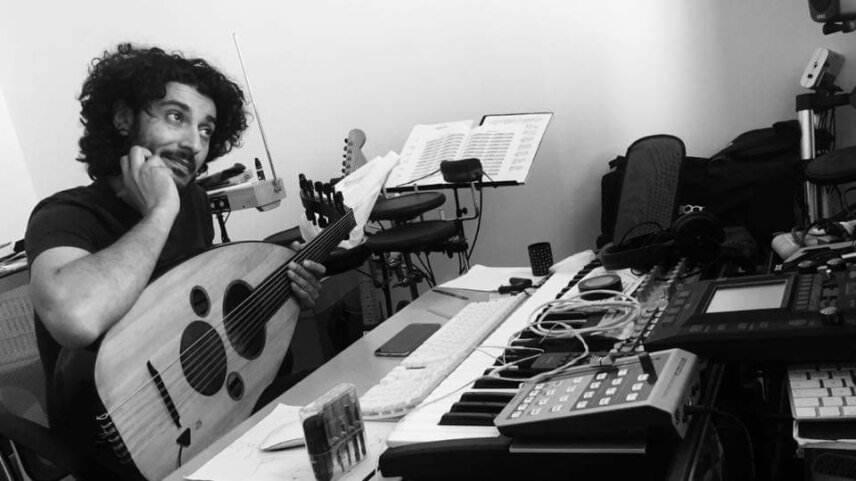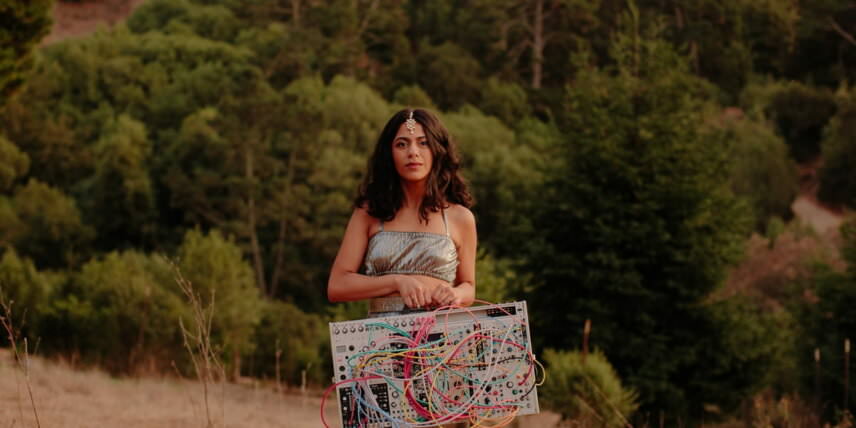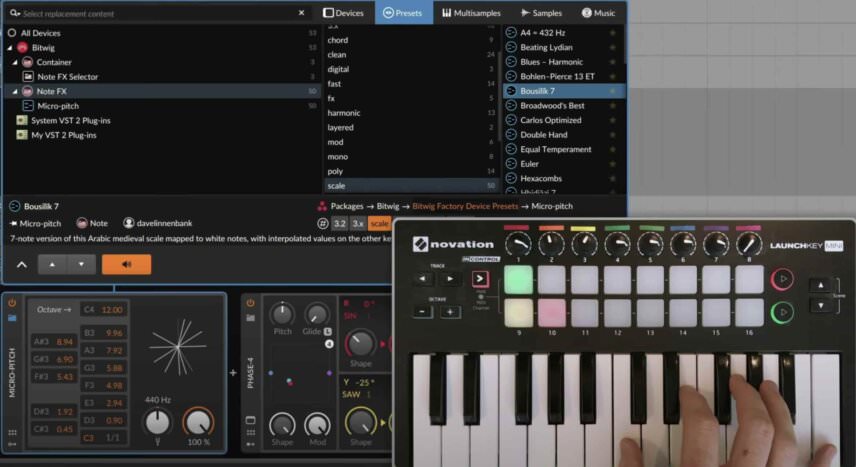Artists and manufacturers are working to explode the piano roll as we know it. There are more than 12 notes out there – but where are they?
There is an unsettling dissonance between how fundamental tuning is to music, and how difficult it is to control as a producer. It bucks the usual trend of digital tools simplifying important processes.
Producers value artistic freedom. They play freely with rhythm – controlling where notes are placed over time. Think of J Dilla’s swinging hip-hop grooves or the polyrhythmic beats of footwork music. But when searching for this freedom regarding tonality (how notes are organised in terms of pitch) they butt their heads against a ceiling that they’d never previously noticed.
Graphic designers aren’t waiting for paint to dry before applying the next layer of colour, so why are electronic musicians still limited by the physical properties of acoustic instruments? And will a new generation of MIDI technology change this? We’ve spoken to producers, academics, and industry insiders to investigate the future of tuning and microtonality.
Tuning Up
There’s a meme that quotes 17th-century treatise ‘Règles de composition’, describing various keys. Is it the dramatic vocabulary that makes it so funny? Or is it also the unexpectedness of giving distinct personalities to keys that are now interchangeable? In the 1600s they had the same notes we do, but they sounded different in every key because of how they were tuned.
Key descriptions from a 1682 treatise
— Threatening Music Notation (@ThreatNotation) February 20, 2022
In the Western world, we currently use 12 notes, and the space between each of these notes (called a semitone) is exactly the same. Therefore, this tuning system is called 12-tone equal temperament, or just equal temperament. This is used to make everything from techno to folk to dubstep to classical.
Assuming this is the natural order of things is like assuming everyone speaks the same language. In fact, this system only became widespread a few hundred years ago. Before then we still used 12 notes, but there was little consensus on where to place each one – the process of tuning. This meant that intervals changed from key to key – with musicians having to retune for any key change.
If you look at musical cultures outside of Europe, it’s a whole different kettle of semitones. The Sitar has moveable frets to account for the diversity of tuning found in Indian ragas. You may have heard the Middle-Eastern Maqam Bayati in action. It’s similar to a minor scale, but the second note is roughly half a semitone flat. The unique intervals this provides can be heard in the Adhan call to prayer, or the riotously joyful sound of dabke.
Who are you calling micro?
‘Microtonal’ is an umbrella term often used for all tonality outside of 12 tone equal temperament. It implies intervals smaller than the Western semitone. But when it’s used to talk about note systems from cultures that never used a semitone in the first place it doesn’t always fit.
Academic and musician Khyam Allami put it to us “if we say ‘non-Western’, we’re centring the West. If we say ‘microtonal’, we’re centring 12 tone equal temperament… so what do we say? This is why I use the words ‘tuning’ and ‘intonation’ as much as I can”.

Going off-key
Some of the most exciting club music of late has a pronounced influence from dabke. Releases like Anunaku & DJ Plead’s ‘032’ have stayed front and centre in our Rekordbox libraries.
We spoke to George Mackness, alias Endless Mow, to catch his perspective on referencing these cultural tunings as an outsider. He ran into trouble integrating the Medieval music that initially inspired him into a club format: “the structure and tonality are obviously very different,” he explained. However, its syncopated rhythms led him to notice parallels between the meandering melodies of Medieval folk and contemporary dabke. This breakthrough led to ‘Romance Me’, which deftly compresses a web of references into a floor-filling club track. Mackness wrote the lead line in equal temperament MIDI before manually retuning notes until the intonation felt right.
Modular synthesist Arushi Jain was trained in classical Hindustani music, and now fuses electronics with the raga form. Speaking to Ableton, she highlighted the difficulty of accessing the correct tunings using a modular system, saying “that kind of control doesn’t exist on my instrument… Everything in electronic music is based in MIDI and there’s not a lot of room to get something to sound good in a different scale”.

MIDI MIDI revolution
MIDI is the digital language that communicates what notes are being played. It offers unparalleled freedom in many respects, yet it is mostly restricted to equal temperament – workarounds have been unwieldy or rarely integrated. With guitar or piano, you stick with equal temperament due to the instrument’s physical limitations. But why should this affect digital instruments?
MIDI has been in use for 39 years. Recently the faithful standard has been updated – MIDI 2.0 was launched in 2020, ready for another four decades of frontline service. MIDI Association President Athan Bilias told us:
“Historically when MIDI started, the goals were quite modest… It was really to expand the ability to do polyphony. And because of that when MIDI was developed, the core foundation of MIDI 1.0 is that it is based on a note number. And that note number is defined by a 12 tone equal temperament scale. So it was very useful – but it was very much in a Western tradition of music.”
While MIDI 2.0 has already been launched, it will take years for its features to trickle down to the technology we use, via firmware updates and new products. The good news is that the improvements on offer mean that notes can be sent at almost any pitch or frequency, rather than one that is tied to equal temperament and then pitch-bent. That technique is the basis for microtonal workarounds in MIDI 1.0, such as the ‘hack’ MPE (Midi Polyphonic Expression) – which Bilias described as a “bridge to MIDI 2.0”.
So that’s everything sewn up? We spoke to Bitwig’s Specification Manager David Linnenbank after noticing their ahead-of-the-curve Micro-pitch device, but he warned that the path ahead wasn’t straightforward:
“Things will get a bit better when [MIDI] 2.0 is everywhere. Although once you start thinking about software instruments, then it’s also plugin standards… Not everyone is doing the same level of MPE support or thinking of it in the same way”.

Allami took matters into his own hands, developing free browser software Apotome and Leimma. He told us:
“If all the DAWs and software synthesizers and hardware synthesizers [offered useable tuning control] then I could do whatever the hell I want. And I wouldn’t have to go around knocking on people’s doors and making a fuss about things – I could just get on with it. The fact that I can’t is the problem”.
Notes of change
It’s clear that a new generation of artists wants to bring tuning back into their musical practice, and they may be the first to have technology on their side. As of now, there are third-party tools emerging that aim to let artists access new (or should that be old?) tunings – including Fluid Pitch, MTS-ESP, as well as the ones we discussed in this article – Bitwig’s Micro-pitch and Apotome & Leimma.
It’s just a matter of time until mainstream DAW and synth manufacturers implement the sort of control over tuning that we currently enjoy for rhythm. Our only hope for the future is that these tuning systems (micro and otherwise) will be represented faithfully to prevent them from becoming an exotic gimmick or alienating end users.
Bertie Coyle is a writer and producer based in London. Follow him on Twitter/ Instagram and hear his music on Soundcloud.
You can check out a full playlist of music references below and over on YouTube.
Don’t forget to hit subscribe also..!
While You’re Here…
If you like this article you might enjoy our book The Secrets of Dance Music Production. It is available from the Attack store!
New customer? Use code ATTACK10WELCOME at checkout for a 10% discount!

